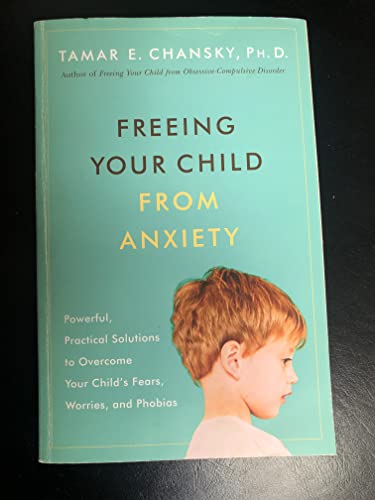Articoli correlati a Freeing Your Child from Anxiety: Powerful, Practical...
Freeing Your Child from Anxiety: Powerful, Practical Strategies to Overcome Your Child's Fears, Phobias, and Worries - Brossura

Sinossi
Citing a significant rise in child anxiety since the September 11 attacks, a guide for parents offers strategies on how to help a child manage stress, sharing insights into the mechanics of anxiety while urging readers to address worry as a solvable problem. Original.
Le informazioni nella sezione "Riassunto" possono far riferimento a edizioni diverse di questo titolo.
Informazioni sull?autore
TAMAR E. CHANSKY, Ph.D., founder of The Children’s Center for OCD and Anxiety, has helped thousands of children overcome fears and gripping mental compulsions. Author ofFreeing Your Child from Obsessive Disorder, she has appeared frequently on television and radio, including National Public Radio'sVoices in the Family and The Parents’ Journal. She lives with her husband and daughters in Philadelphia.
Le informazioni nella sezione "Su questo libro" possono far riferimento a edizioni diverse di questo titolo.
EUR 7,10 per la spedizione da Regno Unito a Italia
Destinazione, tempi e costiCompra nuovo
Visualizza questo articoloEUR 11,54 per la spedizione da Regno Unito a Italia
Destinazione, tempi e costiRisultati della ricerca per Freeing Your Child from Anxiety: Powerful, Practical...
Freeing Your Child from Anxiety: Powerful, Practical Strategies to Overcome Your Child's Fears, Phobias, and Worries
Da: WeBuyBooks, Rossendale, LANCS, Regno Unito
Condizione: Good. Most items will be dispatched the same or the next working day. A copy that has been read but remains in clean condition. All of the pages are intact and the cover is intact and the spine may show signs of wear. The book may have minor markings which are not specifically mentioned. Codice articolo wbs2022998417
Quantità: 1 disponibili
Freeing Your Child from Anxiety: Powerful, Practical Strategies to Overcome Your Child's Fears, Phobias, and Worries
Da: WeBuyBooks, Rossendale, LANCS, Regno Unito
Condizione: Very Good. Most items will be dispatched the same or the next working day. A copy that has been read, but is in excellent condition. Pages are intact and not marred by notes or highlighting. The spine remains undamaged. Codice articolo wbs1425793045
Quantità: 1 disponibili
Freeing Your Child from Anxiety: Powerful, Practical Solutions to Overcome Your Child's Fears, Worries, and Phobias
Da: ThriftBooks-Atlanta, AUSTELL, GA, U.S.A.
Paperback. Condizione: Very Good. No Jacket. May have limited writing in cover pages. Pages are unmarked. ~ ThriftBooks: Read More, Spend Less 0.59. Codice articolo G0767914929I4N00
Quantità: 2 disponibili
Freeing Your Child from Anxiety: Powerful, Practical Solutions to Overcome Your Child's Fears, Worries, and Phobias
Da: ThriftBooks-Dallas, Dallas, TX, U.S.A.
Paperback. Condizione: Very Good. No Jacket. May have limited writing in cover pages. Pages are unmarked. ~ ThriftBooks: Read More, Spend Less 0.59. Codice articolo G0767914929I4N00
Quantità: 1 disponibili
Freeing Your Child from Anxiety: Powerful, Practical Solutions to Overcome Your Child's Fears, Worries, and Phobias
Da: ThriftBooks-Reno, Reno, NV, U.S.A.
Paperback. Condizione: Very Good. No Jacket. May have limited writing in cover pages. Pages are unmarked. ~ ThriftBooks: Read More, Spend Less 0.59. Codice articolo G0767914929I4N00
Quantità: 1 disponibili
Freeing Your Child from Anxiety: Powerful, Practical Solutions to Overcome Your Child's Fears, Worries, and Phobias
Da: ThriftBooks-Phoenix, Phoenix, AZ, U.S.A.
Paperback. Condizione: Very Good. No Jacket. May have limited writing in cover pages. Pages are unmarked. ~ ThriftBooks: Read More, Spend Less 0.59. Codice articolo G0767914929I4N00
Quantità: 1 disponibili
Freeing Your Child from Anxiety: Powerful, Practical Strategies to Overcome Your Child's Fears, Phobias, and Worries
Da: WorldofBooks, Goring-By-Sea, WS, Regno Unito
Paperback. Condizione: Very Good. The book has been read, but is in excellent condition. Pages are intact and not marred by notes or highlighting. The spine remains undamaged. Codice articolo GOR001908709
Quantità: 6 disponibili
Freeing Your Child from Anxiety: Powerful, Practical Solutions to Overcome Your Child's Fears, Worries, and Phobias
Da: Bahamut Media, Reading, Regno Unito
Paperback. Condizione: Very Good. This book is in very good condition and will be shipped within 24 hours of ordering. The cover may have some limited signs of wear but the pages are clean, intact and the spine remains undamaged. This book has clearly been well maintained and looked after thus far. Money back guarantee if you are not satisfied. See all our books here, order more than 1 book and get discounted shipping. Codice articolo 6545-9780767914925
Quantità: 2 disponibili
Freeing Your Child from Anxiety: Powerful, Practical Solutions to Overcome Your Child's Fears, Worries, and Phobias
Da: AwesomeBooks, Wallingford, Regno Unito
Paperback. Condizione: Very Good. Freeing Your Child from Anxiety: Powerful, Practical Solutions to Overcome Your Child's Fears, Worries, and Phobias This book is in very good condition and will be shipped within 24 hours of ordering. The cover may have some limited signs of wear but the pages are clean, intact and the spine remains undamaged. This book has clearly been well maintained and looked after thus far. Money back guarantee if you are not satisfied. See all our books here, order more than 1 book and get discounted shipping. Codice articolo 7719-9780767914925
Quantità: 2 disponibili
Freeing Your Child from Anxiety: Powerful, Practical Solutions to Overcome Your Child's Fears, Worries, and Phobias
Da: medimops, Berlin, Germania
Condizione: good. Befriedigend/Good: Durchschnittlich erhaltenes Buch bzw. Schutzumschlag mit Gebrauchsspuren, aber vollständigen Seiten. / Describes the average WORN book or dust jacket that has all the pages present. Codice articolo M00767914929-G
Quantità: 1 disponibili
